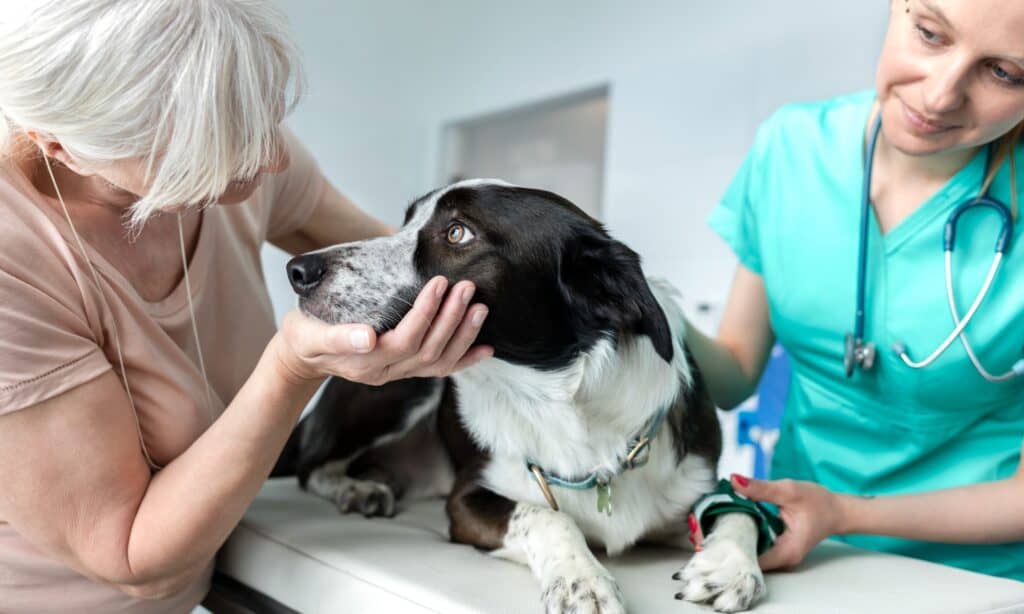As human flu season approaches, you may wonder whether or not your dog is at risk of getting the flu. The short answer is “yes.” Please read below to learn more about the canine flu, its symptoms, treatment, and prevention.
What is canine flu?
Canine flu, like the human flu, is a highly contagious infectious respiratory disease. The virus in question is the influenza A virus, similar to the ones that infect us. However, the canine flu is not yet transferable to humans. The strains particular to dogs originated in horses (H3N8) and birds (H3N2.) H3N8 was first recorded to impact racing dogs (greyhounds) in Florida in 2004. Though it was first found in Asia, a H3N2 outbreak of canine flu happened in the Midwest from 2015-2016. This strain is impacting the U.S. to this day.
How does it spread?

Canine flu is spread by coughing and sneezing as well as contact with contaminated items
©olgagorovenko/Shutterstock.com
Although canine flu is primarily an airborne illness that spreads through coughing, barking, and sneezing. It can also spread via objects like food containers, toys, contaminated surfaces, and people who have been in contact with other dogs which have the virus. The virus transfers through direct proximity, so contagion becomes even more likely in crowded areas like kennels, dog shows, racing tracks, pet stores, dog parks, or during travel.
How long will an infection last?
A dog with canine flu will be contagious beginning with the incubation period, 2-4 days from exposure, whether it displays symptoms or not. The H3N8 strain is transferable up to 10 days after exposure, while H3N2 is contagious up to 26 days after. Many vets recommend a 21-day isolation period to protect other dogs.
A dog exposed to the virus is almost certain to be infected. Even though your dog may not appear sick, it can still spread the virus. 20-25% of infected animals may be asymptomatic, so it’s wise to be alert to possible exposure and to ask your dog’s vet about quarantine procedures.
What are the symptoms?
A dog with the flu will show symptoms like wet or dry cough, sneezing, nasal discharge (possibly pus-filled), runny eyes, fever, lethargy, aversion to food, and trouble breathing. Many of these symptoms resemble kennel cough, but either condition requires treatment. A veterinarian can make that determination.
Some dogs may develop severe complications like viral or bacterial pneumonia, which may cause them to cough up blood. They may have difficulty breathing or develop a high fever of 104 degrees or more. The flu mortality rate is considered low at less than 10%, but there is still a potential for danger, and you should seek immediate treatment for your dog.
How is canine flu treated?

Although there is no cure for dog flu there are things you can do to keep your pet comfortable
©iStock.com/Pratchaya
The most important thing for you to do is take your dog to a veterinarian. To anticipate an outbreak and because the CDC also monitors canine flu, some states require vets to report cases. Vets can also administer a flu test and get a white blood cell count to look for high levels, which may indicate an infection. They can also take x-rays to check for pneumonia.
Since there is no cure for the flu, treatment is supportive, focusing on keeping the dog comfortable. Treatments include:
- Cough suppressants.
- Fluids.
- Non-steroidal anti-inflammatories.
- A vet-approved nutritional plan.
- Possible antibiotics for secondary infections.
- Sometimes, there may be a need for hospitalization.
A veterinarian may direct you to quarantine your dog to protect other animals. They may also be able to give you a list of disinfectants that will help stop the spread of flu through the canine community.
If you suspect flu and are taking your dog to the vet, it is a good idea for you to call ahead to notify them in advance. Preparing for your arrival will help them avoid infecting other animals because they can direct you to an isolated space or ask you to wait outside with your dog.
How can it be prevented?

Vaccinations can be an effective way of preventing serious cases of dog flu
©iStock.com/IPGGutenbergUKLtd
Canine flu is airborne and also spreads through surface contact. To prevent your dog from getting the flu, avoid taking your dog to kennels, pet stores, dog parks, dog shows, racing tracks, or other areas when there is a reported outbreak. Also, be sure to wash your hands regularly–especially if you’ve been in contact with a sick dog. Be aware of any illness in your area. The CDC tracks reports of significant outbreaks, and you may even become aware of these through local animal clinics. Dogflu.com also has an outbreak map.
Your vet may also recommend that you get your dog vaccinated if your dog is in a high-incidence area, travels to shows, or frequently stays in a kennel. After the first vaccination, a booster will be required after 2-4 weeks. After that, it should just be one shot annually.
Can dogs catch the flu from people?
Yes, even though it is highly uncommon. Oregon reported a study where ten cats and one dog were diagnosed with H1N1. Authorities determined that at least one of these cases could be traced back to the pet’s owner.
Can people and other pets catch it?
Your cats and perhaps other pets may be susceptible to catching the flu from your dog. To be safe, you should keep your dog isolated from your other pets, wash your hands regularly, and disinfect common areas.
Though the flu virus can jump from one species to another, there are no human cases to date. However, viruses mutate, and the CDC monitors these mutations to anticipate potential pandemics.
Conclusion
Canine flu is a potential risk for your dog, but with proper precautions and the guidance of a veterinarian, you can substantially reduce the risk for your pet. Consult your vet if your dog is showing signs of being sick, and be sure to wash your hands if you think you may have been around a sick dog. Taking these steps can help you keep your beloved companion safe and healthy.
Up Next
- 6 Reasons Why Your Dog Keeps Coughing
- 6 Reasons Your Dog Is Scratching So Much
- Dog Vomiting: Causes, Concerns, And Treatments
The photo featured at the top of this post is © nik174/Shutterstock.com
Ready to discover the top 10 cutest dog breeds in the entire world?
How about the fastest dogs, the largest dogs and those that are -- quite frankly -- just the kindest dogs on the planet? Each day, AZ Animals sends out lists just like this to our thousands of email subscribers. And the best part? It's FREE. Join today by entering your email below.
Sources
- Dog Flu, Available here: https://www.dogflu.com/about/preventing-the-spread-of-dog-flu
- Wag Walking, Available here: https://wagwalking.com/wellness/can-dogs-get-the-flu-from-humans
- Pet MD, Available here: https://www.petmd.com/dog/conditions/respiratory/c_dg_canine_influenza
- CDC, Available here: https://www.cdc.gov/flu/other/canine-flu/keyfacts.html
Thank you for reading! Have some feedback for us? Contact the AZ Animals editorial team.






